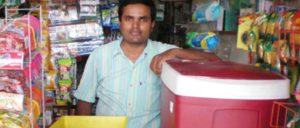Navroze Godrej and Team Chotukool take us into a deep dive to help us understand eight fundamental questions they explored in crafting a path-breaking strategy for Godrej Chotukool

The scene on March 8th 2014 appeared just like a reel out of Aamir Khan-starrer, Taare Zameen Par. A bunch of primary and middle school children were showing off their painting prowess in an art competition sitting inside a wonderfully designed geodesic dome in a rapidly growing city in Maharashtra, 500 km from Mumbai. What stood out was that the kids were not painting on canvas or sheets of chart paper but on a Godrej Chotukool. When quizzed about it, the kid said: “It is a cooling solution where my mother keeps cold water, vegetables and food.”
This was at the launch of the reincarnation of Chotukool, a cooling device, which is a part of Godrej & Boyce’s disruptive innovation initiatives. In every sense, it was unlike any other launch – there was no fanfare, no celebrities and no ribbon cutting. The real celebrities of the day were the school children from various schools who were creating magic with their paintbrushes.
“Why an art competition?” asked a woman entrepreneur (from one of the Self Help Groups), pertinently, to the team of Godrej executives. G Sunderraman, vice-president, corporate development at Godrej & Boyce and a key member of the Godrej Innovation Center, explained to her in the local language (which is translated here): “The essence of the new Chotukool is about creating a sense of pride and identity. Personalization is at the core of it. Each Chotukool can be customized with your choice of a unique piece of art, a digital image, a photograph… you name it. And, that is the art these kids are creating.” He added, much to her delight, “You can even take your family photo and we can embed that print during the manufacturing process when we create your Chotukool.”
This event was conceptualised by Team Chotukool in partnership with SSP (Swayam Shikshan Prayog, a development organisation that works with several micro women entrepreneurs). The unique geodesic dome structure that was erected, the art competition and the interesting invites stoked much more than curiosity, it made people feel like they were a part of something meaningful and distinctly special.
Chotukool, of course, is not new to the market. The product, born out of Godrej & Boyce’s foray into disruptive innovation technology, was first launched in 2009. The company consciously chose to operate under the radar, using the first iteration of Chotukool to understand usage needs of a wide variety of customers.
Over the last few years, Team Chotukool spent quality time with the users in both rural and urban India, which is discussed in detail in this story. It understood that one of the key challenges of the new generation of the product should be to break the barriers between affordability and aspiration. Quite consciously, the latest version, that was recently launched, de-segments the market and has various features that could appeal to a diverse range of people. A customised Chotukool with bespoke art could be used to store expensive beverages and a rural household could use it to store fresh food.
In this story, we take our readers through the eight strategic questions that Team Chotukool asked themselves as they set out on a path of building an aspirational cooling solution that applies to rural and urban life, alike. As Sunderraman says, “The essence of finding the answers is an iterative journey…what all innovations go through.”

We’re gearing up to build the Chotukool, a product that has the potential to disrupt. What do we really mean by innovation and what is the impact it can have?
The question is important because one cannot really define innovation that easily. Navroze Godrej, Executive Director, Godrej & Boyce, agrees and explains, “Innovation is a state of mind. It is the underlying philosophy to think of better ways to do what you do, on an everyday basis, and expand your frames of reference on how you see the world. So, innovation really is a set of lenses, ones that allow you to look at the world in fresh ways, in creative ways, in holistic ways and in more ambitious ways as well.” Clearly, the impact an idea can have on its users is a critical part of any new innovation. With this state of mind, he and his team have worked on transforming Chotukool to be what it is today.
When it was decided that ChotuKool will be sold to emerging market customers, the team realised that they needed to understand a whole new set of parameters that would appeal to them. This is because there were several big brands that were trying to push products to these customers, but the products were not really addressing any of their pain points. Navroze says, “We had to understand what was going to add meaning to the lives of these people.” The company chose to empower them by giving them a greater sense of self-worth and potentially, strengthen their earning power.
Sunderraman recalls an incident from the early days of Chotukool. “I can never forget a conversation I had with Mr. Jamshyd Godrej a few years back. He said, ‘I want to give to the bottom of the pyramid, a product that the top of the pyramid aspires for.’ He believes in exploiting the potential of technology and innovation for the society, at large. We are looking for profit, no doubt. But the struggle for the last few years was to get it right for people with constraints on affordability.”
The leaders of the organisation now believe that they have a good foundation and strong understanding of what needs to be done to build a business for the emerging markets. “As we have that foundation in place, we can now think about how a simple Chotukool can permeate a more evolved consumer’s life,” says Navroze.
Riding on the back of such an enriched perspective, Godrej recently launched the latest Chotukool as an aspirational product that cuts across the traditional rural-urban divide.

How do we, deeply and genuinely, understand the needs of our target groups?
Within the Godrej Innovation Center, one can often sense the deep regard the whole team has for Professor Shoji Shiba, an international expert on breakthrough management. The professor suggested this simple, yet very powerful idea of “jumping into the fishbowl” to develop a deep understanding of whatever you are trying to do. Navroze says, “You need to put yourself right inside the context and understand the feelings of everyone involved.”
As a first step, the company gave the initial set of prototypes to people in rural India who had traditionally been non-users of a cooling device. Several team members, then, closely worked with them to understand their needs and usage patterns.
“It is not just what they liked and did not like, but what was the product doing to the home and family construct? What was it doing for the community? Whenever you are trying to do something new, it is important to think of its larger context. The next question is, what is it doing for the nation?” explains Navroze.
Keeping this is mind, several Chotukool team members stayed in villages for long periods, lived with the families, understanding the habits and needs of not only these people but also its society at large.
Now, that we understand our target group, how do we communicate with them?
While reaching out to a set of users whose needs were still evolving, the approach to communication had to be unique.
The team at Godrej was convinced of the immense benefits that the ‘non-user’ customers would derive from using Chotukool. The team, during its research stint in villages, closely observed various use cases. A small kirana storeowner in rural India would store mineral water bottles in a Chotukool and potentially sell more bottles per day, hence, increasing his earning power. A rural household would use it to store food prepared in the morning to save time and often avoid wastage of food.
Navroze says, “I think the biggest challenge from a communication standpoint is demonstrating these benefits. I think when people see others in their community use the product and talk about it or actually observe its benefit, that is when it has the maximum impact.”
Team Chotukool’s communication strategy revolves around this model of enabling the community to spread the word. The Sakhi Mela (mela for women entrepreneurs part of a SHG), which Godrej conducted in partnership with SSP, is an example of enabling such word-of-mouth. In fact, as part of the launch, a few sakhis (women entrepreneurs) carried some Chotukools, decoratively wrapped around in a silk red cloth. The event was wholly co-created with these women entrepreneurs and this helped them interact with prospective consumers in an environment they were comfortable in. The micro women entrepreneurs answered questions on the benefits of such a cooling device and where it fit into their daily routines.

Even as such events were being organised, the company did not lose sight of its brand story. Often enough, the essence of the story fades and the agenda to sell gains more prominence. “We decided to define the brand story first by citing the impact of our product in the user’s life,” says Sunderraman.
The new ChotuKool, which has several features from the last six years of learning, aims to live up to the promise of an aspirational product at an affordable price point. To communicate this strategy, the company decided to connect emotionally with the user rather than invest in traditional marketing efforts. “Users do not bother about your story, they want to know if you are listening to theirs,” says Sunderraman, outlining the central approach to its communication strategy.
The other obvious aspect is that the behaviour patterns will be different for different markets – be it urban or rural. If one looks at an urban user, Chotukool is more of a useful complement, one that will find use at an office or a bedroom. For people in rural India, while the core value proposition is the functional benefit, one has to respect that they too have aspirations. “We need to realise that they also live within the context of media, what they see in the movies and what their friends do. It is difficult to have clear segmentation models where there is so much cross-flow of information and continuously changing landscapes,” explains Navroze.
For Chotukool, the segmentation of the market is based more on activities, attitudes and usage, rather than on the user. Navroze is convinced that the way forward is to help young Indians feel they deserve better and will get better in the future. Navroze adds, “While communicating the core benefit is crucial, we need to look at how people want to express themselves and what they want to say about their own lifestyles.” And, this concept of letting people “express their taste” is a defining aspect of engagement with all consumers.
How do we make this product really aspirational?
One of the most interesting features in the newly launched version of Chotukool is that it allows the user to personalise the skin design. The skin is essentially a piece of art – one that you can choose from a variety of options designed by artists.
Navroze says, “This is not a brand telling you what you want; it is not a manufacturer saying this is the color, shape and pattern and this is what you want. That is the old way of doing things. In today’s world, people are creating stuff for themselves everywhere. This creative empowerment is really important. It is a brand asking its users, how would you like to see something you have created come to life?”
To enable this, Godrej is also working with a group of artists who will create a number of designs. While the initial approach to building Chotukool was only economic empowerment, with this model, creative empowerment has also come into being. The newly designed website, Chotukool.com, has product features in place to enable the consumer to choose from existing designs created by artists or ‘create your own’.
Fundamentally, Chotukool is not only the effort of its internal team, but also the co-creation efforts of its various partners. Godrej worked with Future Factory, a Mumbai-based industrial and product design firm, to tap their expertise in industrial design. Artists whose designs adorn the Chotukool will be able to boost their earnings. Women entrepreneurs in SHGs will benefit economically by being a conduit to reach the users, in addition, to playing a role in co-creating communication strategies to sell to consumers. Most importantly, users have the choice of co-creating a Chotukool with their unique design. And, this whole process adds meaning to people’s lives.

To implement the strategies discussed above, what sort of team do we build?
Navroze says, “The team was deliberately built up to be multi-disciplinary.” It was a core belief among the senior team that people from different backgrounds and experiences had to come together for a project like this.
In the early days of researching Chotukool, the team was extremely small. It was almost like a startup within Godrej and Boyce that got the prototype out. “You needed a few committed people who would go out there in the world with their feet and ears on the ground. This team played a crucial role in helping us shape our thought process by immersing themselves in the context of the idea of a disruptive cooling device,” explains Navroze.
Today, the team has grown a fair bit and is gearing up to take to market, the personalised Chotukool. People from various backgrounds – designers, MBAs, architects, artists, direct sales professionals and manufacturing engineers, among others – have come together to build this business. Navroze adds, “It is really important for people from different fields to come together and develop a shared understanding of the challenge.” It needs a systematic approach, a set of tools and methods. The innovation center has been building a repository of tools over a period of time.
One such program to build further skills is with IIT Chicago’s Institute of design, where a group of students from different parts of the world work alongside Godrej executives on select themes. It brings about a multi-cultural perspective and Navroze is convinced that this results in lasting solutions, besides building capabilities in structured innovations.
The other interesting approach is to bring key stakeholders from all fields to the table, early on. The marketing person is involved in the product development process; the technology expert has a deep understanding of the usage needs and so on. “But the most important approach is learning by doing…innovations are built on iterative experiments over time,” adds Sunderraman.
While Chotukool is unique today, it would be naïve to think we will not have competition. What is our competitive strategy, going forward?
Before we delve deeper into understanding the competitive strategy, let us understand the core features of the product. The primary offering is that it is a cooling device that offers storage (food, vegetables, cold water) and the benefits of saving time and money that result from it. Today, a sizable percentage of the Indian population does not have access to a refrigerator and Chotukool can potentially address this space.
In addition to cooling, the device is unique in terms of temperature (amount of cooling drop), shape, size, weight, use of non-rusting material and even a sleep mode that makes it more energy efficient. Sunderraman asks, “Are we really competing on any of these parameters? These are all the typical parameters. So, we asked ourselves, can we compete on a whole new dimension?” Answering this question, he says, “It struck us that if we can find a way to make the device stunningly unique, maybe even iconic, we will have a whole new parameter to compete with.” The whole approach to personalisation with unique pieces of art thus began. Of course, today, co-creation of design with users is a part of the engagement process.

“Almost 80 per cent of the Indian population does not have a refrigerator and if more people want to enter this segment, the market will expand,” declares Sunderraman. Moreover, Godrej does not have the capacity to serve the entire need of the market. As Sunderraman says, “It is not about competing to have a larger market share. It is about competing to get a piece of the market that you are interested in and where you can play to your distinctive capabilities.”
“Does it mean that we are fully protected against competition? Not really. Some new innovation can hit us very hard and from corners we do not know,” he adds. The company needs to keep an eye on the market, understand the larger domain and identify the various blind spots with respect to technology, users and market. So, it’s not competition, it’s competing alternatives. “The moment you start imagining your success, start imagining what could lead to its failure, you start preparing yourself for it,” he says. In other words, at any point of time if you lose your humility or fail to look at the outside world, or don’t pay attention to what is constantly changing, you will get into trouble.
What will our logistics and distribution strategy be? And, how do we price the product?
The Chotukool strategy – across its various business functions from marketing and communication to product development and technology – is unique, thanks to the approach of its leaders and the mindset to create social impact. From a logistics standpoint, this meant that it had to figure out a way to reach out these products to widely dispersed markets in India while retaining its affordable price point of around Rs. 4,690 (higher for a customised device).
For distribution and logistics, Godrej has partnered with India Post. The company has setup Chotukool kiosks at select post offices in Maharashtra, Gujarat and Tamil Nadu, where the postal staff has been trained to explain the features of the cooling device to walk-in customers. One can deposit cash and expect to receive the Chotukool within three weeks. Through this partnership, women entrepreneurs will sell Chotukool in their villages and make a commission on sales.
Additionally, Godrej has also setup a direct sales team to visit the homes of customers to help them custom design a Chotukool, using an interactive tablet, and also buy one if they like.
Sunderraman believes that, over time, selling online will become a critical part of the B2C sales process. Users will visit Chotukool.com, create their own designs (or a selection from the basket of designs) and order their selection of Chotukool. The customised Chotukool will be delivered at their doorstep within three weeks.
The most interesting aspect on its logistics is that it’s a two-way chain. The design comes from the customer (through Chotukool.com) and is fed into the manufacturing process. The entire logistics platform is interlinked with the web portal.
Godrej also plans to setup migrating experience centers built as geodesic domes in various parts of India – both rural and urban. Sunderraman believes that this is a unique way of reaching out to spread out markets, where spaces, that come alive with engagement, will be established.

Where do we see Chotukool, five years from now?
Navroze says, “The dream is to create a platform of products that will empower people both economically and creatively. We originally wanted to build cooling products to improve people’s lives, especially in emerging markets. The current vision is to extend that philosophy to new landscapes beyond cooling.”
The team at the Godrej Innovation Center has already started working on the next few domains, but feel it is too early to speak about them.
“We have now begun to understand the various unmet needs we want to solve. It is extremely important to prioritise these and offer solutions in thoughtful, efficient and elegant ways,” says Navroze, as he wraps up.
Did you know?
THE UNDERLYING TECHNOLOGY AND PRODUCT SPECS OF CHOTUKOOL
Chotukool can offer up to a drop of 28°C from the surrounding temperature, as it works on Solid State Technology with a Thermo-electric Chip, instead of refrigerator compressors. Team Chotukool wanted to create a cooling solution that is portable, compact, economical and “just right”. It consumes 62W of power, has an internal capacity of 35 Liters, weighs 7.3 Kgs and can keep items cool for 2-3 hours without electricity.
Did you know?
CHOTUKOOL’S SOCIAL IMPACT
Chotukool hopes to create social impact by helping tackle 3 Ls – livelihood, living standard and lifestyle. It won Gold in Edison Awards 2012 for social impact.
15 fascinating elements from Team Chotukool’s approach of creating markets that don’t exist
Jamshyd Godrej’s vision of giving to the bottom of the pyramid, a product that the top of the pyramid aspires for
Looking at the process of innovation through multiple lenses
‘Jumping into the fish bowl’ and getting the team members to put themselves right inside the context and understand the feelings of all stakeholders involved
Building a product based on not only what it was doing to a set of consumers but also looking at the impact it had on the community and society at large
Conceptualizing and creating a process by which every Chotukool can be personalized with a unique piece of art, photography, digital image etc
Co-creating various parts of the process including product development and communicating with customers
Segmenting the market based more on activities, attitudes and usage, rather than by user
Understanding that emerging market users and balancing their affordability and aspirations
Competing on a whole new dimension by making the device stunningly unique, rather than compete on the typical parameters of cooling drop, size etc.
Building a multidisciplinary team with people from various backgrounds working together and develop a shared understanding of the challenge
Focus on learning by doing… and realizing that innovations are built on iterative experiments over time
Playing to the distinctive capabilities of Team Chotukool
Overcoming tough manufacturing process challenges to ensure that every Chotukool can be customised
Devising a business model while still at a price point of Rs. 4690
Work towards a dream of creating a platform of products that will empower people both economically and creatively
Tete-a-Tete with Navroze Godrej
KEY MANAGEMENT LESSONS LEARNT FROM THE CHOTUKOOL JOURNEY
• Be aware of your surroundings and the context that you are in. As someone who is working with multiple complexities, it is critical to be responsive towards what is going on around you.
• Stick to your guns. It is very easy for a good idea to dilute itself. It is critical to understand what you are trying to achieve and understand the bigger picture and philosophy behind it and stick to that.
YOUR LEARNINGS FROM MR. JAMSHYD GODREJ THAT HELPS IN YOUR PROFESSIONAL LIFE
I have observed a few things, not sure if I am following it: His ability to take in information and then translate that into what is most needed and important, ability to move between big picture, goals, and philosophies, value systems that drives the company and finally, getting into the micro details about how things work and how to improve things – these are few things I have observed.
One of his biggest strengths is the ability to listen. He has an amazing way of allowing people to express themselves, allowing them to try new things and be patient. I hope to imbibe them someday.
WHAT INSPIRES YOU?
What inspires me is art – fine arts, performing arts and artists – as it leaves behind such a rich legacy for many generations. Art has a lot to offer business as one can learn from people who are able to express themselves and are able to convey a larger meaning for what drives us, as people. It is that sort of purity and integrity that is very fundamental to art which we often lose sight of in the business world.
YOUR OPINION ON PERCEPTION VS. REALITY – IS IT IMPORTANT TO CREATE THE RIGHT PERCEPTION AND HOW DO YOU RETAIN THAT PERCEPTION?
I do not know if you can draw a distinction between perception and reality. Perception has to be earned by serving the customer well rather than creating an aura around it. Traditionally, businesses like to control this perception. But that is incorrect. It is entirely dependent on how people use and perceive it. In today’s world, if people try to control that, it will work against them.